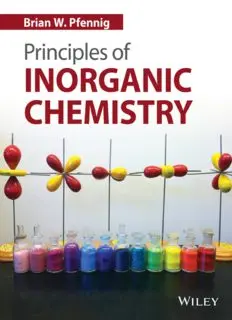
Principles of inorganic chemistry PDF
Preview Principles of inorganic chemistry
PRINCIPLES OF INORGANIC CHEMISTRY PRINCIPLES OF INORGANIC CHEMISTRY Brian W. Pfennig Copyright©2015byJohnWiley&Sons,Inc.Allrightsreserved PublishedbyJohnWiley&Sons,Inc.,Hoboken,NewJersey PublishedsimultaneouslyinCanada Nopartofthispublicationmaybereproduced,storedinaretrievalsystem,ortransmittedinanyform orbyanymeans,electronic,mechanical,photocopying,recording,scanning,orotherwise,exceptas permittedunderSection107or108ofthe1976UnitedStatesCopyrightAct,withouteithertheprior writtenpermissionofthePublisher,orauthorizationthroughpaymentoftheappropriateper-copyfee totheCopyrightClearanceCenter,Inc.,222RosewoodDrive,Danvers,MA01923,(978)750-8400,fax (978)750-4470,oronthewebatwww.copyright.com.RequeststothePublisherforpermissionshould beaddressedtothePermissionsDepartment,JohnWiley&Sons,Inc.,111RiverStreet,Hoboken,NJ 07030,(201)748-6011,fax(201)748-6008,oronlineathttp://www.wiley.com/go/permissions. LimitofLiability/DisclaimerofWarranty:Whilethepublisherandauthorhaveusedtheirbesteffortsin preparingthisbook,theymakenorepresentationsorwarrantieswithrespecttotheaccuracyor completenessofthecontentsofthisbookandspecificallydisclaimanyimpliedwarrantiesof merchantabilityorfitnessforaparticularpurpose.Nowarrantymaybecreatedorextendedbysales representativesorwrittensalesmaterials.Theadviceandstrategiescontainedhereinmaynotbe suitableforyoursituation.Youshouldconsultwithaprofessionalwhereappropriate.Neitherthe publishernorauthorshallbeliableforanylossofprofitoranyothercommercialdamages,includingbut notlimitedtospecial,incidental,consequential,orotherdamages. Forgeneralinformationonourotherproductsandservicesorfortechnicalsupport,pleasecontact ourCustomerCareDepartmentwithintheUnitedStatesat(800)762-2974,outsidetheUnitedStates at(317)572-3993orfax(317)572-4002. Wileyalsopublishesitsbooksinavarietyofelectronicformats.Somecontentthatappearsinprintmay notbeavailableinelectronicformats.FormoreinformationaboutWileyproducts,visitourwebsiteat www.wiley.com. LibraryofCongressCataloging-in-PublicationData: Pfennig,BrianWilliam. Principlesofinorganicchemistry/BrianW.Pfennig. pagescm Includesbibliographicalreferencesandindex. ISBN978-1-118-85910-0(cloth) 1. Chemistry,Inorganic–Textbooks.2. Chemistry,Inorganic–Studyandteaching(Higher)3. Chemistry, Inorganic–Studyandteaching(Graduate)I.Title. QD151.3.P462015 546–dc23 2014043250 Coverimage:Courtesyoftheauthor Typesetin10/12ptGillSansbyLaserwordsPrivateLimited,Chennai,India. PrintedintheUnitedStatesofAmerica 10987654321 1 2015 Contents Preface xi Acknowledgements xv Chapter1 | TheCompositionofMatter 1 1.1 EarlyDescriptionsofMatter 1 1.2 VisualizingAtoms 6 1.3 ThePeriodicTable 8 1.4 TheStandardModel 9 Exercises 12 Bibliography 13 Chapter2 | TheStructureoftheNucleus 15 2.1 TheNucleus 15 2.2 NuclearBindingEnergies 16 2.3 NuclearReactions:FusionandFission 17 2.4 RadioactiveDecayandtheBandofStability 22 2.5 TheShellModeloftheNucleus 27 2.6 TheOriginoftheElements 30 Exercises 38 Bibliography 39 Chapter3 | ABriefReviewofQuantumTheory 41 3.1 TheWavelikePropertiesofLight 41 3.2 ProblemswiththeClassicalModeloftheAtom 48 3.3 TheBohrModeloftheAtom 55 3.4 ImplicationsofWave-ParticleDuality 58 3.5 PostulatesofQuantumMechanics 64 3.6 TheSchrödingerEquation 67 3.7 TheParticleinaBoxProblem 70 3.8 TheHarmonicOscillatorProblem 75 Exercises 78 Bibliography 79 Chapter4 | AtomicStructure 81 4.1 TheHydrogenAtom 81 4.1.1 TheRadialWaveFunctions 82 4.1.2 TheAngularWaveFunctions 86 4.2 PolyelectronicAtoms 91 4.3 ElectronSpinandthePauliPrinciple 93 4.4 ElectronConfigurationsandthePeriodicTable 96 4.5 AtomicTermSymbols 98 vi CONTENTS 4.5.1 ExtractingTermSymbolsUsingRussell–SaundersCoupling 100 4.5.2 ExtractingTermSymbolsUsingjjCoupling 102 4.5.3 CorrelationBetweenRS(LS)CouplingandjjCoupling 104 4.6 ShieldingandEffectiveNuclearCharge 105 Exercises 107 Bibliography 108 Chapter5 | PeriodicPropertiesoftheElements 109 5.1 TheModernPeriodicTable 109 5.2 Radius 111 5.3 IonizationEnergy 118 5.4 ElectronAffinity 121 5.5 TheUniquenessPrinciple 122 5.6 DiagonalProperties 124 5.7 TheMetal–NonmetalLine 125 5.8 StandardReductionPotentials 126 5.9 TheInert-PairEffect 129 5.10 RelativisticEffects 130 5.11 Electronegativity 133 Exercises 136 Bibliography 137 Chapter6 | AnIntroductiontoChemicalBonding 139 6.1 TheBondinginMolecularHydrogen 139 6.2 LewisStructures 140 6.3 CovalentBondLengthsandBondDissociationEnergies 144 6.4 Resonance 146 6.5 PolarCovalentBonding 149 Exercises 153 Bibliography 154 Chapter7 | MolecularGeometry 155 7.1 TheVSEPRModel 155 7.2 TheLigandClose-PackingModel 170 7.3 AComparisonoftheVSEPRandLCPModels 175 Exercises 176 Bibliography 177 Chapter8 | MolecularSymmetry 179 8.1 SymmetryElementsandSymmetryOperations 179 8.1.1 Identity,E 180 8.1.2 ProperRotation,C 181 n 8.1.3 Reflection,𝜎 182 8.1.4 Inversion,i 183 8.1.5 ImproperRotation,S 183 n 8.2 SymmetryGroups 186 8.3 MolecularPointGroups 191 8.4 Representations 195 8.5 CharacterTables 202 8.6 DirectProducts 209 8.7 ReducibleRepresentations 214 Exercises 222 Bibliography 224 CONTENTS vii Chapter9 | VibrationalSpectroscopy 227 9.1 OverviewofVibrationalSpectroscopy 227 9.2 SelectionRulesforIRandRaman-ActiveVibrationalModes 231 9.3 DeterminingtheSymmetriesoftheNormalModesofVibration 235 9.4 GeneratingSymmetryCoordinatesUsingtheProjectionOperatorMethod 243 9.5 ResonanceRamanSpectroscopy 252 Exercises 256 Bibliography 258 Chapter10 |CovalentBonding 259 10.1 ValenceBondTheory 259 10.2 MolecularOrbitalTheory:Diatomics 278 10.3 MolecularOrbitalTheory:Polyatomics 292 10.4 MolecularOrbitalTheory:piOrbitals 305 10.5 MolecularOrbitalTheory:MoreComplexExamples 317 10.6 BoraneandCarboraneClusterCompounds 325 Exercises 334 Bibliography 336 Chapter11 |MetallicBonding 339 11.1 CrystallineLattices 339 11.2 X-RayDiffraction 345 11.3 Closest-PackedStructures 350 11.4 TheFreeElectronModelofMetallicBonding 355 11.5 BandTheoryofSolids 360 11.6 ConductivityinSolids 374 11.7 ConnectionsBetweenSolidsandDiscreteMolecules 383 Exercises 384 Bibliography 388 Chapter12 |IonicBonding 391 12.1 CommonTypesofIonicSolids 391 12.2 LatticeEnthalpiesandtheBorn–HaberCycle 398 12.3 IonicRadiiandPauling’sRules 404 12.4 TheSilicates 417 12.5 Zeolites 422 12.6 DefectsinCrystals 423 Exercises 426 Bibliography 428 Chapter13 |StructureandBonding 431 13.1 AReexaminationofCrystallineSolids 431 13.2 IntermediateTypesofBondinginSolids 434 13.3 QuantumTheoryofAtomsinMolecules(QTAIM) 443 Exercises 449 Bibliography 452 Chapter14 |StructureandReactivity 453 14.1 AnOverviewofChemicalReactivity 453 14.2 Acid–BaseReactions 455 14.3 FrontierMolecularOrbitalTheory 467 viii CONTENTS 14.4 Oxidation–ReductionReactions 473 14.5 AGeneralizedViewofMolecularReactivity 475 Exercises 480 Bibliography 481 Chapter15 |AnIntroductiontoCoordinationCompounds 483 15.1 AHistoricalOverviewofCoordinationChemistry 483 15.2 TypesofLigandsandNomenclature 487 15.3 StabilityConstants 490 15.4 CoordinationNumbersandGeometries 492 15.5 Isomerism 498 15.6 TheMagneticPropertiesofCoordinationCompounds 501 Exercises 506 Bibliography 508 Chapter16 |Structure,Bonding,andSpectroscopyofCoordinationCompounds 509 16.1 ValenceBondModel 509 16.2 CrystalFieldTheory 512 16.3 LigandFieldTheory 525 16.4 TheAngularOverlapMethod 534 16.5 MolecularTermSymbols 541 16.5.1 Scenario1—AlltheOrbitalsareCompletelyOccupied 546 16.5.2 Scenario2—ThereisaSingleUnpairedElectroninOneoftheOrbitals 546 16.5.3 Scenario3—ThereareTwoUnpairedElectronsinTwoDifferentOrbitals 546 16.5.4 Scenario4—ADegenerateOrbitalisLackingaSingleElectron 547 16.5.5 Scenario5—ThereareTwoElectronsinaDegenerateOrbital 547 16.5.6 Scenario6—ThereareThreeElectronsinaTriplyDegenerateOrbital 547 16.6 Tanabe–SuganoDiagrams 549 16.7 ElectronicSpectroscopyofCoordinationCompounds 554 16.8 TheJahn–TellerEffect 564 Exercises 566 Bibliography 570 Chapter17 |ReactionsofCoordinationCompounds 573 17.1 KineticsOverview 573 17.2 OctahedralSubstitutionReactions 577 17.2.1 Associative(A)Mechanism 578 17.2.2 Interchange(I)Mechanism 579 17.2.3 Dissociative(D)Mechanism 580 17.3 SquarePlanarSubstitutionReactions 585 17.4 ElectronTransferReactions 593 17.5 InorganicPhotochemistry 606 17.5.1 PhotochemistryofChromium(III)AmmineCompounds 607 17.5.2 Light-InducedExcitedStateSpinTrappinginIron(II)Compounds 611 17.5.3 MLCTPhotochemistryinPentaammineruthenium(II)Compounds 615 17.5.4 PhotochemistryandPhotophysicsofRuthenium(II)PolypyridylCompounds 617 Exercises 622 Bibliography 624 Chapter18 |StructureandBondinginOrganometallicCompounds 627 18.1 IntroductiontoOrganometallicChemistry 627 18.2 ElectronCountingandthe18-ElectronRule 628
